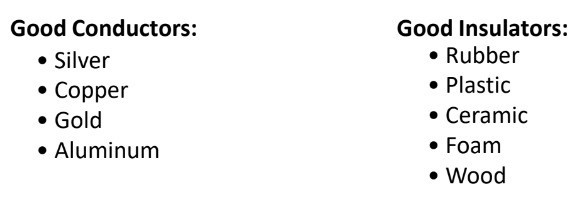Standards
Science – SC.5.P.10.3
Investigate and explain that an electrically charged object can attract an uncharged object and can either attract or repel another charged object without any contact between objects.
Science – SC.5.P.11.2
Identify and clarify materials that conduct electricity and materials that do not.
Language Arts – LAFS.5.SL.1.1
Engage effectively in a range of collaborative discussions (one-on-one, in groups, and teacher-led) with diverse partners on grade 5 topics and texts, building on others’ ideas and expressing their own clearly.
Mathematics – MAFS.5.NBT.2.7
Add, subtract, multiply, and divide decimals to hundredths, using concrete models or drawings and strategies based on place value, properties of operations, and/or the relationship between addition and subtraction; relate the strategy to a written method and explain the reasoning used.
Big Idea(s)
Electric charge is the physical property of matter that causes it to experience a force when placed in an electromagnetic field. There are two types of electric charges; positive and negative (commonly carried by protons and electrons respectively). Like charges repel and unlike charges attract.

Essential Questions
- What causes an electric charge to occur?
- What is the relationship between an insulator and a conductor?
Vocabulary
Static Electricity • Force • Electric Force • Repel • Attract • Electric Discharge • Magnet • Insulator • Conductor
Background Information
Electric charge occurs when a buildup of electricity transfers from one object to another. The electric force will either attract or repel depending on the charge. Static electricity is a form of energy. Energy can move to make things work. Since we are made up of mostly water, electricity can move through our body to try to get to the ground, and that’s why we must act. There are good and bad conductors of heat and electricity. Some good conductors of are silver, copper, gold, and aluminum.
Guiding Questions
- How does electricity work?
- What materials are good conductors of electricity?
- What parts are needed in order to make an electrical circuit?
- What is an electrical current and how do they work?
- How can electrical currents be used in order to make a magnet?
- What can electricity flow through?
- What are the effects of moving charges?
- What causes an atom to have a negative or positive charge?
- What effect might be caused by electrons being loosely bound to atoms in a material?
- Is it possible to categorize all conductors as metals? Why or why not?
- What is the difference between an insulator and a conductor?
- If an insulator is placed into a series circuit containing a battery and a light bulb, will the light bulb be able to light? Why or why not?
- If a conductor is placed into a series circuit containing a battery and a light bulb, will the light bulb be able to light? Why or why not?
- What is static electricity?
- Have you ever dragged their feet across the room? What happened when they touched something afterward?
Instructional Sequence
- Introduction to Understanding Electrical Charges Good and Bad Conductors of Heat and Electricity – Lesson - Classroom Carousel Discussion
- Science Lesson –
- Lesson - Testing for Conductivity with Different Conductors and Insulators
- Lesson - Static Electricity: Balloon Labs
- Lesson - Balloons and Static Electricity Labs
- Lesson - Exploring Electrical Forces Lab
- Lesson - Separating Salt and Pepper with Static Electricity Lab
Math Mania
Hydropower is a renewable source of energy. It provided 3.3 of the 98 quads* of energy we used in 2010. Energy experts predict hydropower production will remain about the same during the next eight years. If their predictions are correct, how many total quads of energy will be provided during the next eight years?
The answer is:
26.4 quads
*Quad – one quadrillion (a thousand trillion) BTUs. The unit is used by the U.S. Department of Energy in discussing world and national energy budgets.
Fun Facts
Did you know…
- That although humans cannot see UV light, some insects have the ability to see it?
- That the reason we see different colors of light is because each color has a different wavelength?
Inquiry Type
- Structured Inquiry – Lesson - Classroom Discussion
- Controlled Inquiry/Pairs – Lesson - Static Electricity (Understanding Charges)
- Guided Inquiry/Small Groups – Activity - Static Electricity Labs (Inquiry)
